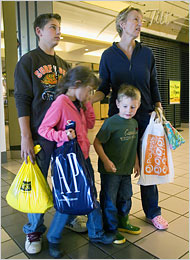 |
 |
 |
 Business News | September 2007 Business News | September 2007  
Currency Parity Brings Canadian Shoppers South
 Doug Benz - NYTimes Doug Benz - NYTimes
go to original


| | Debbie Eldridge of Surrey, British Columbia, shopping with her children in a Bellingham, Wash., mall. (Peter Yates/NYTimes) |
Blaine, Wash. — Tracey Carle checked the Web on Friday morning to see the wait times at the border and then bolted to the United States to shop.

Ms. Carle left her home in the border town of Surrey, British Columbia, cruised through the increasingly tight border here in a relatively breezy 34 minutes, stopped immediately to gas up her sport utility vehicle on the cheap at the U.S.A. Mini Mart and shot down Interstate 5 toward her real target, Target.

“Anytime in the last few years it’s been better,” said Ms. Carle, 49, explaining that she has long crossed the border for bargains. “But now, this is just whoo-hoo!”

The whoo-hoo part, as Ms. Carle and countless other Canadians have demonstrated recently, is tied directly to the steady rise of the Canadian dollar against its American counterpart in recent years, becoming its economic equal this week for the first time in three decades.

On either side of the border, a buck is now a buck, or as Canadians call it on their side, a loonie. Coupled with high prices and high taxes for many things in Canada, the strength of the Canadian dollar is driving Canadians into the United States to shop for shoes, school supplies, gasoline, used cars and second homes.

“It’s huge,” said Jessica Smith, a stockbroker who lives near Toronto and spent the day shopping with a friend in nearby Niagara Falls, N.Y. “But for my clients with investments in the U.S., it wipes them out.”

Sure enough, not everyone is giddy. The weakness of the American dollar worries some Canadian investors as well as businesses that rely on American customers. It is also not helping American tourism in Canada, where the number of visitors from the United States has been declining since before the terrorist attacks of Sept. 11, 2001.

The rush to cross into the United States is complicated by new restrictions at the border, where proof of nationality is increasingly expected and passports are set to become mandatory as early as January. Here at the busy crossing in Blaine, the border is likely to be even more clogged because of construction to expand the number of lanes in preparation for the 2010 Winter Olympics in Vancouver, British Columbia.

“We’re looking at a flood, but the dam is the border, and it’s tough getting everything through that border,” said Mike Kent, a real estate agent in Birch Bay, an area south of Blaine where Mr. Kent said Canadians had been buying property that looks at the pricier hills of their homeland.

“In a perfect world, the dollar would have gone par when the border was finished,” Mr. Kent said. “It’s come at exactly the wrong time.”

Still, Mr. Kent and others in real estate and retail on the United States side of the border are pleased by the turnaround. Five years ago, the Canadian dollar was worth just more than 60 cents in American money.

“They were always reminding you of how much it cost them,” Debbie Morley, the manager at West Marine Express, a boat supply store in Blaine, said of Canadian shoppers, who provide 60 percent to 70 percent of the store’s business. “Now they’re just so happy. They say, ‘I can buy more!’ ”

Experts emphasize that the shifts in the border economy have not occurred overnight, that the loonie has been inching toward equality for several years. Some Canadians said Friday that they had shopped in the United States even when the Canadian dollar was weak, because of better prices.

Hart Hodges, director of the Center for Economic and Business Research at Western Washington University, noted that while the number of Canadians coming across the border has been increasing in recent months, the numbers remain far lower than they were before the border became tighter. He also said that many major American retailers had opened stores in Canada since the last time the Canadian dollar was strong, in the early 1990s, and that Canadians who shopped south were now often seeking specific items like electronics or specials at Target and Nordstrom.

Yet the idea of “parity” in the two currencies has added momentum to make the crossing. “Everybody’s talking about it at work,” said Ms. Carle.

In Vermont, Buzz Roy, owner of Brown’s Drugstore in Derby Line, said of his Canadian customers: “They don’t buy anything in particular, but everything in general. We’ve seen a gradual increase over the summer, and we’ve seen a bigger increase this week.”

Mr. Roy said more customers would make trips if it were easier to cross the border, “but they’re still coming in droves.”

In North Dakota, Crystal Schlecht, who works for the City of Cavalier, said the arts and crafts show in town last weekend had a surprisingly international feel in spite of the slow-go at the border crossing.

“I’d say 60 percent of the people the whole weekend were from Canada,” she said. “And we’ve never really had that before.”

William Yardley reported from Blaine, Wash., and Katie Zezima from Boston. David Staba contributed from Niagara Falls, N.Y. | 
 | |
 |



